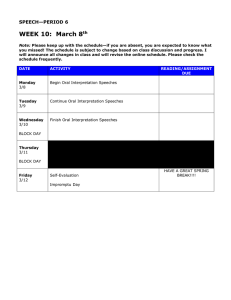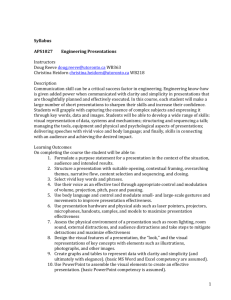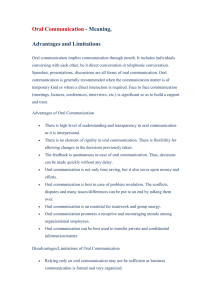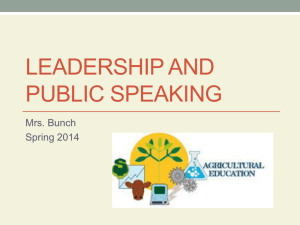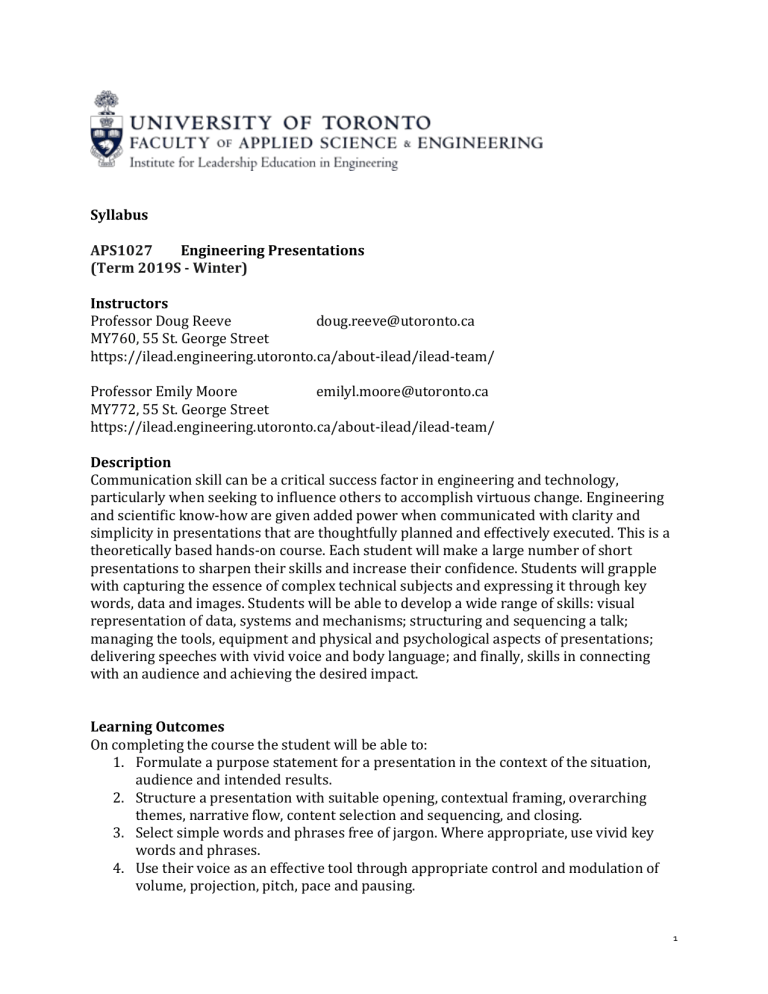
Syllabus
APS1027
Engineering Presentations
(Term 2019S - Winter)
Instructors
Professor Doug Reeve
doug.reeve@utoronto.ca
MY760, 55 St. George Street
https://ilead.engineering.utoronto.ca/about-ilead/ilead-team/
Professor Emily Moore
emilyl.moore@utoronto.ca
MY772, 55 St. George Street
https://ilead.engineering.utoronto.ca/about-ilead/ilead-team/
Description
Communication skill can be a critical success factor in engineering and technology,
particularly when seeking to influence others to accomplish virtuous change. Engineering
and scientific know-how are given added power when communicated with clarity and
simplicity in presentations that are thoughtfully planned and effectively executed. This is a
theoretically based hands-on course. Each student will make a large number of short
presentations to sharpen their skills and increase their confidence. Students will grapple
with capturing the essence of complex technical subjects and expressing it through key
words, data and images. Students will be able to develop a wide range of skills: visual
representation of data, systems and mechanisms; structuring and sequencing a talk;
managing the tools, equipment and physical and psychological aspects of presentations;
delivering speeches with vivid voice and body language; and finally, skills in connecting
with an audience and achieving the desired impact.
Learning Outcomes
On completing the course the student will be able to:
1. Formulate a purpose statement for a presentation in the context of the situation,
audience and intended results.
2. Structure a presentation with suitable opening, contextual framing, overarching
themes, narrative flow, content selection and sequencing, and closing.
3. Select simple words and phrases free of jargon. Where appropriate, use vivid key
words and phrases.
4. Use their voice as an effective tool through appropriate control and modulation of
volume, projection, pitch, pace and pausing.
1
5. Use body language and control and modulate small- and large-scale gestures and
movements to improve presentation effectiveness.
6. Use presentation hardware and physical aids such as laser pointers, projectors,
microphones, handouts, samples, and objects to suit diverse situations.
7. Assess the physical environment of a presentation such as room lighting, room
sound, external distractions, and audience distractions and take steps to mitigate
distractions and minimize obstacles to audience engagement.
8. Design the visual features of a presentation, the “look,” and the visual
representations of key concepts with illustrations, photographs, animations etc.
9. Create graphs and tables to represent data with clarity and simplicity (and
ultimately with elegance). (basic MS Word and Excel competency are assumed).
10. Use PowerPoint to assemble visual elements to support speech. (basic PowerPoint
competency is assumed).
11. Evaluate a presentation and assess its effectiveness (including self-evaluation)
12. Formulate and deliver feedback to a presenter (including self-feedback).
13. Devise a methodology for preparation of a presentation including planning content
and all elements of form, practicing and previewing.
14. Appreciate the challenges and importance of cross-cultural communication.
15. Listen to questions from an audience and respond directly.
16. Ask questions of a presenter in a manner that adds to the collective knowledge of all
listeners.
Teaching Methods
1. Short speeches on engineering and other subjects, illustrated and not, informative
and persuasive, and in various forms such as: a technical talk, an elevator pitch, a
chalk talk, a toast, and an introduction
2. Very short speeches for practicing basic skills: voice, pace, gestures, body language,
etc.
3. Video recording and review of speeches. These recordings will only be used for class
purposes.
4. Exercises and homework such as readings, video viewing, speech analysis and
preparation and practice of speeches
5. Viewing, reading, analyzing and re-delivering great speeches
6. Exercises and homework preparing graphs, tables and diagrams - hand drawn and
computer drawn
7. Self- and peer-evaluation of, and feedback on, presentations
8. Workshops using participatory techniques such as Pictionary and improvisation
9. Written assignments such as: a speech for a formal introduction, and a speech for a
personal occasion
10. Extemporaneous speeches
11. In-class discussions
Assignments
Students will be required to prepare presentation materials, present them and, in most
cases, submit them for assessment, feedback and grading, generally, assuming an educated,
non-specialist audience (the class). Some assignments are submitted both as a first draft
2
and, after feedback and refinement, a second draft.
1. A One-minute Introduction – A written speech introducing yourself
2. A Short Technical Talk – Speaking Points
3. A Hand-drawn Illustration or Diagram – Students must prepare a diagrammatic
drawing of a process, a device, or a piece of engineering equipment – hand-drawn
on paper.
4. An XY Graph of Data – Students must prepare an XY graph representing a prescribed
data set. The graph should be computer generated and made into a PowerPoint
slide.
5. A PowerPoint Illustration or Diagram – Students must prepare a diagrammatic
drawing of a process, a device, or a piece of engineering equipment – using
PowerPoint (Note: Downloading drawings or diagrams is not acceptable.)
6. A One-minute Technical Talk – A technical talk about an aspect of engineering that
you think is important.
7. A Chalk Talk – A talk about a technical subject that you illustrate (with chalk on a
chalk board) as you tell your audience about it.
8. A One-minute Toast – A written speech for special occasion by which you honour and
recognize the accomplishments or special character of a person, organization,
group, etc. (In this case you may choose another type of audience: family, friends,
etc.)
9. A Three-minute Technical Talk – a three-slide presentation about an aspect of
engineering that you think is important.
Reference Materials
Books
Made to Stick: Why Some Ideas Survive and Others Die by Chip Heath and Dan Heath,
2008 Website: heathbrothers.com
Slide Rules – Design, Build and Archive Presentations in the Engineering and Technical
Fields by Traci Nathans-Kelly and Christine G. Nicometo (available as an ebook in
the University library
Engineering Communication: From Principles to Practice by Robert Irish and Peter
Eliot Weiss, 2009
Canadian Public Speaking by Melanie Novis, Pearson/Prentice Hall, 2004
The Oxford Dictionary of Quotations edited by Elizabeth Knowles, 7th Edition, 2009
Lend Me Your Ears – Great Speeches in History selected and introduced by William
Safire, 2004
Websites
The Three-minute Thesis - The original started by the University of Queensland:
http://threeminutethesis.org/
The Three-minute Thesis National Competition https://cags.ca/3mt/
The Alan Alda Institute for Communicating Science - The Flame Challenge https://www.aldacenter.org/outreach/flame-challenge
3
4

